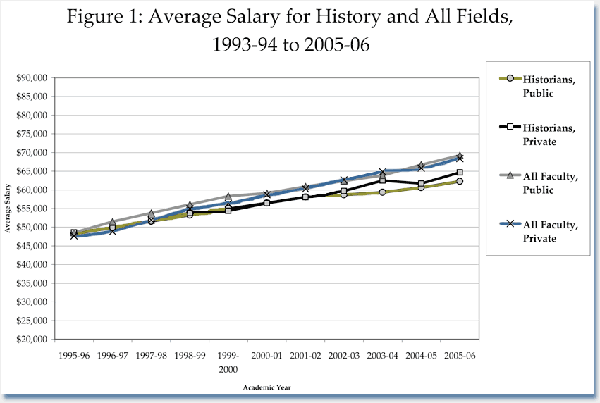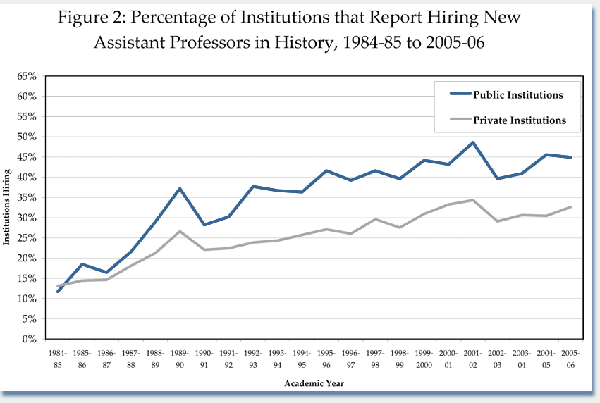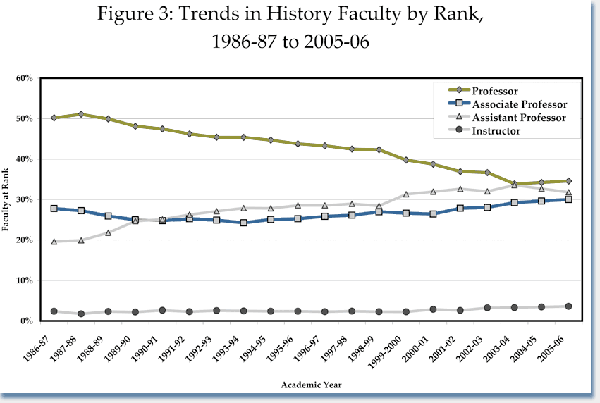News
The 2005-06 Salary Report: History Still Lags, but Sees Modest Gains at Private Institutions
Salaries for historians in academia gained a little ground this past year—at least at private institutions—after lagging ever further behind average salaries for the academy over the past few years. The average salary for historians at four-year institutions rose from $61,006 in the 2004–05 academic year to $63,119, according to a new report from the College and University Personnel Association for Human Resources (CUPA-HR).
The report provides information on the nine-month salaries for almost 6,200 historians at 705 four-year colleges and universities. This is only a partial representation of the full number of historians employed and the institutions that employ them, but does provide the most up-to-date barometer of historians’ income.1
The gain could be seen at every rank among private colleges and universities. The average salaries for faculty at those institutions rose 4.8 percent over the average reported the year before, while average salaries among faculty in all disciplines at those institutions rose 3.9 percent (Table 1). In comparison, salaries for historians at public institutions grew by just 2.7 percent over the year before, lagging well behind the 3.7 percent increases reported for faculty in all fields.

It should be noted, however, that the improvement for historians at private institutions followed a modest (and unexpected) decrease the year before, which suggests that some of the changes from year to year could have occurred as a result of variations in the mix of institutions that responded to the survey. Still, this survey provides a key benchmark for administrators at many colleges and universities, so it remains an important measure for faculty in the discipline as they negotiate salary adjustments for continuing faculty as well as starting salaries for new faculty.
The average salary for new assistant professors is particularly important for the discipline. When the starting salaries for new assistant professors began to fall relative to the average for faculty in other disciplines a decade ago, it marked the start of a trend that has dragged down the average salaries for faculty further up the ranks as the new assistant professors of a decade ago became the associate and full professors of today.
Getting off to a bad start tends to hobble a faculty member’s subsequent earning potential, and these ripple effects can be seen in the trends for the field as a whole. Just a decade ago, history was near parity with other disciplines, but that gap has grown steadily since (Figure 1).

Regrettably, the weakness in salaries for new hires continues this year. The smallest salary increases could be seen among the starting salaries for new history faculty hired to teach in 2005–06 as compared to 2004–05. At private institutions, new assistant professors in history started with an average salary of $46,100—just 3.4 percent higher than among those hired for the 2004–05 term. At public institutions the increase was even more modest, with an average of $45,529—an increase of just 2.5 percent. This indicates that even though the job market for historians in the academy has improved for some in the discipline, the surfeit of history PhDs means the institution still retains the stronger bargaining position in most hires.
According to the survey, the gap between the highest paid history professor and the lowest paid instructor remains vast. The professor earning the highest salary took home $237,766 from one of the public universities, according to the report. The highest paid professor at one of the responding private institutions earned $193,000. In comparison, the lowest paid instructor in the discipline earned $21,410 at a public college.
This gap pales in comparison to the gap among faculty in all fields (excluding the health sciences), which was $785,280 at the top compared to $12,532 at the bottom. It will hardly be a surprise that the highest average salaries were among faculty in the law schools, where the average salary is $115,638. The lowest average salaries were in English departments, with an average salary of $57,621.
The report also suggests the importance of collective bargaining in the salaries for historians at public institutions. The average salaries for historians at institutions with collective bargaining were almost 10 percent higher—$66,064 as compared to $60,312 at institutions without collective bargaining. Given that the highest paid professor and the lowest paid instructor in the discipline are both at collective bargaining schools, however, the average cannot be taken as a measure of collective achievement.
Regardless of the collective bargaining arrangement, the growth in history salaries at public colleges and universities lagged behind the other disciplines. From the 2004–05 to 2005–06 academic year, the average salary for historians without collective bargaining rose 2.6 percent, while at schools with collective bargaining, the average rose 2.8 percent.
Of course, average salaries are only one mark of the total income that goes into the livelihood of historians in the academy (or any other area of employment). For a more complete picture of the wider range of income streams and benefits (though regrettably, only from back in fall 2003) see the article on the recent federal faculty survey in the March 2006 issue of Perspectives.
Continued Improvement in Hiring
Since the reports from CUPA-HR provide evidence about the hiring of new assistant professors in the discipline, we also use their reports as a point of comparison for our own surveys of the academic job market. Their report confirms the generally positive news we have reported—at least at the broad disciplinary level—as the number of new assistant professors grew for the third year in a row.
Almost one-third of the responding departments reported that they had hired a new assistant professor for the 2005–06 academic year—311 new assistant professors in history were hired by the 705 reporting departments.
In a bit of a change from recent hiring trends, much of the gain occurred at private institutions. While the proportion of public colleges and universities reporting new hiring was essentially flat, hirings at private institutions rose almost 26 percent (Figure 2). The number of junior faculty hired by departments at private institutions increased from 92 to 106 new faculty, while the number hired by public institutions slipped a tiny bit from 212 to 205 new historians.

The sharp increase in new hiring over the past decade continues to have an important effect on the composition of history departments. As shown in Figure 3, the proportion of faculty at the top rank had fallen steadily over the past two decades. The proportion of full professors in history departments stood at over 51 percent in the 1986–87 academic year, but fell to 34 percent of the history faculty in 2003–04 academic year. This decline in the proportion of senior faculty has been closely paralleled by the lagging of salaries for faculty in the field.

Our analysis of trends among faculty based on data derived from the Directory of History Departments, Historical Organizations, and Historians indicates that the decline in senior ranks is the result of a wave of retirements by faculty hired in the late 1960s and early 1970s, paired with a general increase in the number of faculty employed in history departments to serve a growing student population. Within the past two years, however, the trend reversed slightly. The proportion of full professors has grown, as junior faculty hired in the recent extended wave finally begin to move up into the higher ranks.
One can hope that this increase in the proportion of history faculty at the top ranks will be accompanied by an improvement in the institutional prestige and authority necessary to press for full and fair compensation for scholars in the discipline.
—Robert Townsend is assistant director for research and publications at the AHA.
Note
1. CUPA-HR, National Faculty Salary Survey by Discipline and Rank in Four-Year Colleges and Universities (published annually for the academic years 1986–87 through 2005–06). Salary figures are based on a nine- or ten-month academic year, full-time faculty only. Fringe benefits and summer earnings are excluded. Copies can be obtained from CUPA-HR at 1233 20th St. NW, Ste. 301, Washington, DC 20036-1250 or through its web site at www.cupahr.org/.
Tags: Profession
Comment
Please read our commenting and letters policy before submitting.






